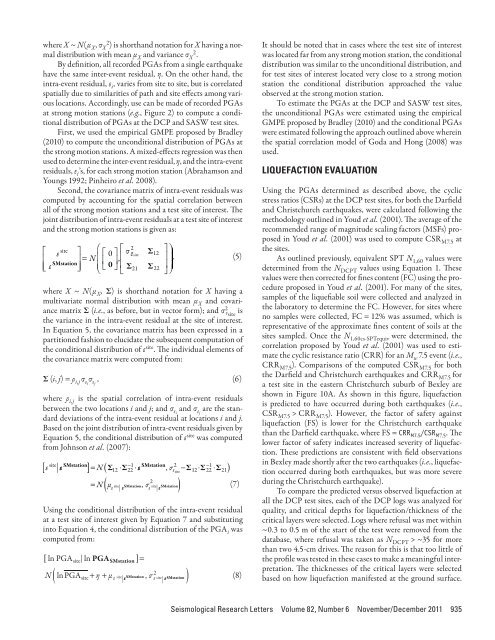Here - Stuff
Here - Stuff
Here - Stuff
Create successful ePaper yourself
Turn your PDF publications into a flip-book with our unique Google optimized e-Paper software.
where X ~ N(μ X , σ X 2 ) is shorthand notation for X having a normaldistribution with mean μ X and variance σ X 2 .By definition, all recorded PGAs from a single earthquakehave the same inter-event residual, η. On the other hand, theintra-event residual, ε i , varies from site to site, but is correlatedspatially due to similarities of path and site effects among variouslocations. Accordingly, use can be made of recorded PGAsat strong motion stations (e.g., Figure 2) to compute a conditionaldistribution of PGAs at the DCP and SASW test sites.First, we used the empirical GMPE proposed by Bradley(2010) to compute the unconditional distribution of PGAs atthe strong motion stations. A mixed-effects regression was thenused to determine the inter-event residual, η, and the intra-eventresiduals, ε i ’s, for each strong motion station (Abrahamson andYoungs 1992; Pinheiro et al. 2008).Second, the covariance matrix of intra-event residuals wascomputed by accounting for the spatial correlation betweenall of the strong motion stations and a test site of interest. Thejoint distribution of intra-event residuals at a test site of interestand the strong motion stations is given as:εsiteε = N 0 σ ε Σ0 , site 12, (5)Σ 21 Σ 22SMstation2where X ~ N(μ X , Σ) is shorthand notation for X having amultivariate normal distribution with mean μ X and covariancematrix Σ (i.e., as before, but in vector form); and σ 2 ε siteisthe variance in the intra-event residual at the site of interest.In Equation 5, the covariance matrix has been expressed in apartitioned fashion to elucidate the subsequent computation ofthe conditional distribution of ε site . The individual elements ofthe covariance matrix were computed from:Σ (i, j) = ρ i,j σ εiσ εj, (6)where ρ i,j is the spatial correlation of intra-event residualsbetween the two locations i and j; and σ εiand σ εjare the standarddeviations of the intra-event residual at locations i and j.Based on the joint distribution of intra-event residuals given byEquation 5, the conditional distribution of ε site was computedfrom Johnson et al. (2007):site SMstation1 SMstation 2[ ε ε ] = N ( Σ 12 Σ 22 ε , σεΣsite 12 Σ22 1 Σ21)= N με ε , 2(site SMstation σεsite ε ) (7)SMstationUsing the conditional distribution of the intra-event residualat a test site of interest given by Equation 7 and substitutinginto Equation 4, the conditional distribution of the PGA i wascomputed from:[ ln PGA site ln PGA SMstation ]=2( )N ln PGA site + η + μ ε σsite ε SMstation , ε site ε (8)SMstationIt should be noted that in cases where the test site of interestwas located far from any strong motion station, the conditionaldistribution was similar to the unconditional distribution, andfor test sites of interest located very close to a strong motionstation the conditional distribution approached the valueobserved at the strong motion station.To estimate the PGAs at the DCP and SASW test sites,the unconditional PGAs were estimated using the empiricalGMPE proposed by Bradley (2010) and the conditional PGAswere estimated following the approach outlined above whereinthe spatial correlation model of Goda and Hong (2008) wasused.LIQUEFACTION EVALUATIONUsing the PGAs determined as described above, the cyclicstress ratios (CSRs) at the DCP test sites, for both the Darfieldand Christchurch earthquakes, were calculated following themethodology outlined in Youd et al. (2001). The average of therecommended range of magnitude scaling factors (MSFs) proposedin Youd et al. (2001) was used to compute CSR M7.5 atthe sites.As outlined previously, equivalent SPT N 1,60 values weredetermined from the N DCPT values using Equation 1. Thesevalues were then corrected for fines content (FC) using the procedureproposed in Youd et al. (2001). For many of the sites,samples of the liquefiable soil were collected and analyzed inthe laboratory to determine the FC. However, for sites whereno samples were collected, FC = 12% was assumed, which isrepresentative of the approximate fines content of soils at thesites sampled. Once the N 1,60cs-SPTequiv were determined, thecorrelation proposed by Youd et al. (2001) was used to estimatethe cyclic resistance ratio (CRR) for an M w 7.5 event (i.e.,CRR M7.5 ). Comparisons of the computed CSR M7.5 for boththe Darfield and Christchurch earthquakes and CRR M7.5 fora test site in the eastern Christchurch suburb of Bexley areshown in Figure 10A. As shown in this figure, liquefactionis predicted to have occurred during both earthquakes (i.e.,CSR M7.5 > CRR M7.5 ). However, the factor of safety againstliquefaction (FS) is lower for the Christchurch earthquakethan the Darfield earthquake, where FS = CRR M7.5 /CSR M7.5 . Thelower factor of safety indicates increased severity of liquefaction.These predictions are consistent with field observationsin Bexley made shortly after the two earthquakes (i.e., liquefactionoccurred during both earthquakes, but was more severeduring the Christchurch earthquake).To compare the predicted versus observed liquefaction atall the DCP test sites, each of the DCP logs was analyzed forquality, and critical depths for liquefaction/thickness of thecritical layers were selected. Logs where refusal was met within~0.3 to 0.5 m of the start of the test were removed from thedatabase, where refusal was taken as N DCPT > ~35 for morethan two 4.5-cm drives. The reason for this is that too little ofthe profile was tested in these cases to make a meaningful interpretation.The thicknesses of the critical layers were selectedbased on how liquefaction manifested at the ground surface.Seismological Research Letters Volume 82, Number 6 November/December 2011 935
















